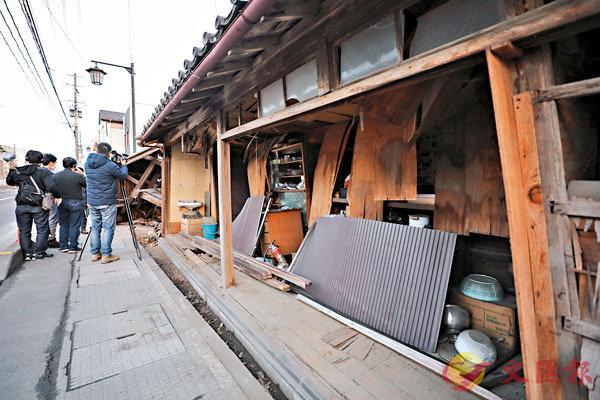 ●建築物因地震而受損。 資料圖片
●建築物因地震而受損。 資料圖片【原文】下文摘錄自香港《文匯報》2月15日︰
日本東北地區(Tohoku region)2月13日晚發生黎克特制7.3級地震,造成至少152人受傷,超過90萬戶一度停電,並引發山泥傾瀉。今次地震震感強烈,不少居民坦言憶起10年前「311」大地震的可怕景象。氣象廳(Japan Meteorological Agency)分析認為,今次地震是「311」大地震的餘震(aftershock),雖然沒有發出海嘯(tsunami)警報,但提醒國民仍有機會發生強震,而氣象廳14日時再錄得5.2級地震。
地震在當地時間13日晚11時07分(香港時間10時07分)發生,震央(epicenter)位於福島縣(Fukushima)外海,震源深度約55公里,由北海道(Hokkaido)至本州(Honshu)西部均有震感。氣象廳根據體感等實際情況,將地震震度分為10個級別,當晚地震最大震度屬第二高的「6強」,是福島縣繼「311」大地震以來,首次再錄得「6強」震級。
氣象廳同時指出,今次地震相信是「311」大地震的餘震,根據以往經驗,未來仍可能發生強震,呼籲居民注意安全。首相菅義偉(Yoshihide Suga)14日早上召開內閣會議,向受災民眾表示慰問,指示各部門要與地區官員緊密合作,為應對餘震作好準備,又敦促災區民眾繼續保持警惕(vigilance)。內閣官房長官加藤勝信(Katsunobu Kato)警告,由於預測未來數天將降雨,可能會發生更多山泥傾瀉。
據日本消防部門統計,截至當地時間14日晚6時,日本全國已有152人在地震中受傷,集中在災情最嚴重的福島縣及宮城縣(Miyagi),傷者主要是骨折或被玻璃碎片割傷,並無生命危險。福島、宮城兩地均有火災發生,福島有公路因山泥傾瀉被堵塞。許多房屋在地震中損毀,逾90萬戶一度停電,到14日清晨6時已基本恢復(restore)供電,不過仍有數千戶斷水。由於地震造成路軌損毀及停電,JR東日本(JR East)部分新幹線(shinkansen)路線停駛,當局預計需10天時間才能全線恢復通車。
不少居民在社交平台上載地震時的片段,可見超市一片狼藉,貨品東歪西倒,有居民的房間物品散落一地,雪櫃門被劇烈搖晃至打開,居民驚慌尖叫。
46歲的星野葵(Aoi Hoshino)(譯音)在福島縣磐城市(Iwaki)經營酒吧,她表示店內的酒瓶全部被震落地上碎裂,指當晚地震令她想起10年前「311」大地震的可怕場面,她感到十分驚慌,身體不斷顫抖。星野葵又大嘆酒吧生意已受新冠疫情重創,本來期望隨着15日解除緊急事態(state of emergency)可以復業,豈料又發生地震,可謂禍不單行。
2011年3月11日,日本東北部海域發生9級大地震,引發大型海嘯,造成逾1.8萬人死亡或失蹤。而在2018年9月,北海道北部發生6.6級地震,引發多處山泥傾瀉,逾40人喪生。
152 injured in Fukushima 7.3-magnitude earthquake, recalling nightmare 10 years ago
【譯文】A powerful magnitude 7.3 earthquake struck the Tohoku region of Japan on the evening of 13 February, causing at least 152 injuries, over 900,000 homes temporarily losing power as well as landslides. The strong earthquake reminded many residents of the horrible scenes of the 3/11 killer quake nearly 10 years ago. According to the Japan Meteorological Agency, the earthquake this time was believed to be an aftershock of the 3/11 killer earthquake. Although no tsunami warning was issued, there might still be the possibility of a strong earthquake, while a 5.2-magnitude quake was recorded again on 14 February.
The earthquake struck at around 11:07 p.m. local time (10:07 p.m. HK time) on 13 February, with the epicenter located off the coast of Fukushima and the focus estimated to be at a depth of about 55 kilometers. It was felt in wide areas in Japan from Hokkaido to western Honshu. The agency had classified the earthquake intensity into 10 levels according to the degree of shaking, and the late-night quake registered a strong 6 on the Japanese seismic intensity scale - the second-highest level and the first time for Fukushima to record a strong 6 since the 3/11 killer earthquake.
The agency pointed out that the quake was believed to be an aftershock of the 3/11 killer earthquake, and more strong earthquakes might occur anytime according to past experience, urging people in the affected areas to stay alert. Prime Minister Yoshihide Suga expressed condolence to the affected people at a meeting of Cabinet ministers on 14 February morning, and instructed relevant departments to work closely with regional officials in order to respond swiftly to potential aftershocks, as well as urged vigilance among the community. Chief Cabinet Secretary Katsunobu Kato warned that more landslides might occur as it was likely to have heavy rain in the next couple of days.
According to statistics of the Japanese fire department, 152 injuries were reported across the country, particularly in the Fukushima and Miyagi regions, as at 6 p.m. local time on 14 February. The injuries ranged from broken bones to cuts from shattered glass, but no deaths were reported. Fires occurred in Fukushima and Miyagi, and landslides had resulted in closure of roads in Fukushima. Many houses were damaged during the earthquake and over 900,000 households suffered from temporary power outages. Electricity supply was basically restored by 6 a.m. on 14 February, but thousands of households were still without water supply. Due to the damage of railway tracks and power outages caused by the earthquake, the JR East suspended certain shinkansen bullet train services and estimated that it would take around 10 days for the services to return to full operation.
Videos posted on social media showed that supermarkets were in a mess with items spilled off the shelves, and the belongings inside residents' homes strewn across the floor. The doors of refrigerator were opened due to the strong shaking and people screamed in panic.
Aoi Hoshino, 46, with a small bar in the city of Iwaki, Fukushima prefecture, said that all her whiskey bottles were broken and shattered in the late-night strong earthquake, bringing back the frightening memories of the 3/11 killer earthquake 10 years ago and making her very scared and trembling. She said that the business was already hard hit by the coronavirus pandemic and she had been looking forward to reopening the bar after lifting the state of emergency originally scheduled for 15 February. Unexpectedly, the plan was again disrupted by the earthquake.
On 11 March, 2011, a 9-magnitude offshore earthquake shook northeastern Japan, triggering a series of tsunami that claimed more than 18,000 lives; while a 6.6-magnitude earthquake struck northern Hokkaido in September 2018, causing multiple landslides and over 40 deaths.●龐嘉儀
Q&A
1. 日本「311」大地震的主要受災縣城有哪些?
2. 「311」大地震引發的巨大海嘯導致福島發生什麼事故?
3. 承上題,是次事故被列為國際核事件分級表中的第幾級?
4. 日本位於哪個地震活躍區?
Answer
1. 福島、岩手(Iwate)、宮城
2. 福島第一核電站事故(Fukushima Daiichi nuclear disaster)
3. 第7級(最高級別)
4. 環太平洋火山帶(Ring of Fire)

